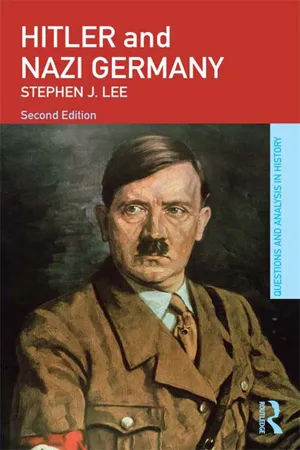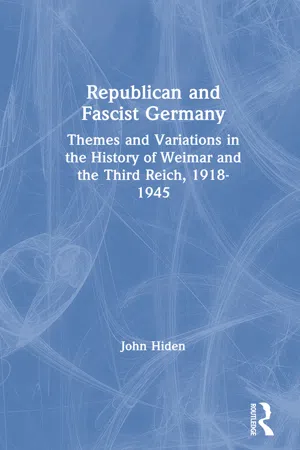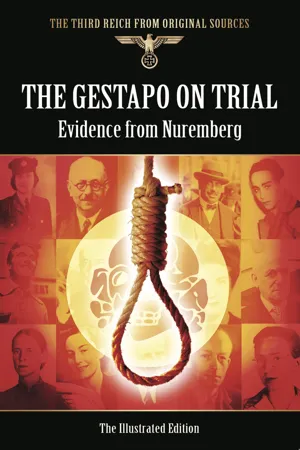History
Gestapo
Written by Perlego with AI-assistance
Related key terms
Related key terms
1 of 4
Related key terms
1 of 3
5 Key excerpts on "Gestapo"
- eBook - ePub
- United States. Office of Chief of Counsel for the Prosecution of Axis Criminality(Author)
- 2017(Publication Date)
- Perlego(Publisher)
The evidence shows that the Gestapo was created by Goering in Prussia in April 1933 for the specific purpose of serving as a police agency to strike down the actual and ideological enemies of the Nazi regime, and that henceforward the Gestapo in Prussia and in the other States of the Reich carried out a program of terror against all who were thought to be dangerous to the domination of the conspirators over the people of Germany. Its methods were utterly ruthless. It operated outside the law and sent its victims to the concentration camps. The term “Gestapo” became the symbol of the Nazi regime of force and terror.Behind the scenes, operating secretly, the SD, through its vast network of informants, spied upon the German people in their daily lives, on the streets, in the shops, and even within the sanctity of the churches.The most casual remark of a German citizen might bring him before the Gestapo, where his fate and freedom were decided without recourse to law. In this government, in which the rule of law was replaced by a tyrannical rule of men, the Gestapo was the primary instrumentality of oppression.The Gestapo and the SD played an important part in almost every criminal act of the conspiracy. The categories of these crimes, apart from the thousands of specific instances of torture and cruelty in policing Germany for the benefit of the conspirators, indicate the extent of Gestapo and SD complicity. - eBook - ePub
- Stephen J. Lee(Author)
- 2013(Publication Date)
- Routledge(Publisher)
While the Gestapo certainly intensified the pressure to attain compliance with Nazi anti-Semitism, for example, it could not on its own enforce even the more rudimentary racial policies designed to isolate the Jews. From the case-files it appears that many individuals, especially members of official and semi-official organizations and associations, members of the Nazi Party, and others in positions of authority (such as medical doctors, nurses, welfare officials), collaborated with the Gestapo in the endeavour to enforce racial policy. When it came to separating the Jews from other persons in Germany, a great deal of such volunteered information was forthcoming. Much of this assistance was not required by law or by orders from above. While Gestapo officials intensified their efforts to bring pressure to bear, to achieve National-Socialist ends, the Gestapo’s operations would have been seriously hampered without the provision from non-official sources of information on suspected deviations from the new behavioural norms. Source 2.3: From the editor’s introduction to an article by K. Mallmann and G. Paul, ‘Omniscient, Omnipotent, Omnipresent? Gestapo, society and resistance’ (published in 1994) Ever since 1933, the Gestapo has been the ultimate symbol of that typically twentieth-century nightmare, the totalitarian police state. In the following article, Mallmann and Paul show, however, that the popular image of the Gestapo is a ‘myth’ originally propagated by the Gestapo leaders themselves. After the war, historians perpetuated this myth of the ‘omniscient, omnipotent, omnipresent’ Gestapo by taking the Gestapo leaders’ statements of aims and ambitions as accurate reflections of everyday Gestapo practices - eBook - ePub
Republican and Fascist Germany
Themes and Variations in the History of Weimar and the Third Reich, 1918-1945
- John Hiden(Author)
- 2020(Publication Date)
- Routledge(Publisher)
3 . Ibid., p. 42.At the same time, the greater awareness of the conflict-ridden nature of the Third Reich’s administration has focused more attention on how policing worked and how the Gestapo could operate so effectively with the comparatively limited resources at its disposal. Except for those in Würzburg-Lower Franconia and Düsseldorf, Gestapo case files have been destroyed. Detailed study of the first region - not notably pro-Nazi - has given a picture of the Gestapo as a compact top group relying heavily on information provided by many individuals and agencies. Membership of the Gestapo itself was remarkably small and even by the end of 1944 stood at only 32,000, of which the 15,500 or so ‘executive officials’ carried out the real tasks of political policing.4 In enforcing racial policy in particular, tip-offs provided the major cause of Gestapo investigations. Most of the denouncements came from the lower end of the social scale but all social groups were implicated in the process; informing transcended class barriers. Motives were highly variable and could include personal grievances; only a minority seem to have been prompted by loyalty to the government. Nonetheless, denunciations - together with the ease with which the traditional police forces became acclimatized to the new order – were in effect supportive of the system between 1933 and 1945.4 . R. Gellately, The Gestapo and German Society, p. 44.QUALIFYING THE ‘SS STATE’
The celebrated pervasiveness of the Gestapo takes on new meanings in this context, which is certainly not to deny the fear that it could instil in its victims. Yet the concept of extensive self-policing indicates also that the terror system of the Third Reich was more open than many have admitted. This idea is in fact a far more uncomfortable one to have to cope with than the argument advanced in the earlier but enormously influential study by H. Krausnick and M. Broszat, Anatomy of the SS State. The perfectly understandable concern of these historians - to try to trace ‘the day to day practice of totalitarian tyranny’ – yielded vital insights into the nature of terror and of the concentration camps.5 At the same time it gave a misleading impression of the uniformity of policing after 1933 and tended to overlook the extent to which the policed participated in the whole process of controlling ‘criminality’.6 - eBook - ePub
The Gestapo on Trial
Evidence from Nuremberg
- Bob Carruthers(Author)
- 2014(Publication Date)
- Pen & Sword Military(Publisher)
A. An organisation has members. The officials of the Secret State Police were officials employed by the State, and they occupied a public position. An organisation sets its own aims. The officials of the Secret State Police received their orders from the State and from the State leaders.Q. Did the Gestapo belong in any way to the NSDAP or to the National Socialist organisation?A. No, the officials of the Gestapo were purely and simply State officials.Q. Witness, please speak a little more slowly. Otherwise, the interpreters cannot keep up.A. Very well.Q. Was there a uniform Secret State Police set up in January, 1933, throughout the territory of the German Reich?A. No. In the individual German States, political police systems were set up which were created by the various State governments concerned.Q. Were these police systems entirely new?A. No, they were brought about through the regrouping and reorganisation of the political police systems which already existed.Q. In what way did this take place?A. Through the orders or decrees of the State governments concerned.Q. For what reasons were these new authorities created by the State governments?A. I can state from my own personal experience that in the State of Hesse a State police system was created, as the authority of the police had been shaken by the events that occurred before 1933, and the authority of these officials had to be restored once more, through a new kind of political police, especially in relation to the members of the National Socialist movement. I assume that this motive also carried weight in other German States.Passage contains an image
Q. Did you yourself suggest the deportation of Jews from Denmark as has been mentioned here occasionally?A. - eBook - ePub
- United States. Office of Chief of Counsel for the Prosecution of Axis Criminality(Author)
- 2017(Publication Date)
- Perlego(Publisher)
Chart No. 1 ) is enough to show how completely it differed from the political parties we know. It had its own source of law in the fuehrer and sub-fuehrers. It had its own courts and its own police. The conspirators set up a government within the Party to exercise outside the law every sanction that any legitimate state could exercise and many that it could not. Its chain of command was military, and its formations were martial in name as well as in function. They were composed of battalions set up to bear arms under military discipline, motorized corps, flying corps, and the infamous “Death Head Corps”, which was not misnamed. The Party had its own secret police, its security units, its intelligence and espionage division, its raiding forces, and its youth forces. It established elaborate administrative mechanisms to identify and liquidate spies and informers, to manage concentration camps, to operate death vans, and to finance the whole movement. Through concentric circles of authority, the Nazi Party, as its leadership later boasted, eventually organized and dominated every phase of German life—but not until they had waged a bitter internal struggle characterized by brutal criminality. In preparation for this phase of their struggle, they created a party police system. This became the pattern and the instrument of the police state, which was the first goal in their plan.The Party formations, including the Leadership Corps of the Party, the SD, the SS, the SA and the infamous Secret State Police, or Gestapo—all these stand accused before you as criminal organizations; organizations which, as we will prove from their own documents, were recruited only from recklessly devoted Nazis, ready in conviction and temperament to do the most violent of deeds to advance the common program. They terrorized and silenced democratic opposition and were able at length to combine with political opportunists, militarists, industrialists, monarchists, and political reactionaries.On January 30, 1933 Adolf Hitler became Chancellor of the German Republic. An evil combination, represented in the prisoners’ dock, by its most eminent survivors, had succeeded in possessing itself of the machinery of the German Government, a facade behind which they thenceforth would operate to make a reality of the war of conquest they so long had plotted. The conspiracy had passed into its second phase.
Index pages curate the most relevant extracts from our library of academic textbooks. They’ve been created using an in-house natural language model (NLM), each adding context and meaning to key research topics.
Explore more topic indexes
Explore more topic indexes
1 of 6
Explore more topic indexes
1 of 4




